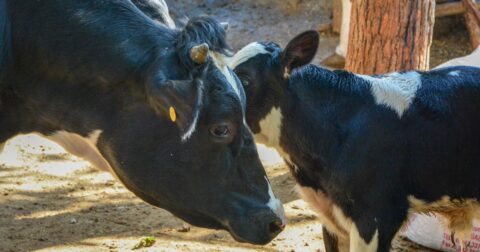Reported
Fish Farms Kill Billions More Wild Fish Than Previous Estimates, Study Finds
Research•6 min read
Reported
The genetic link between orcas and cows might surprise you.


Words by Jessica Scott-Reid
The release of the wildly popular documentary Blackfish set in motion a massive shift in public opinion. After the film exposed how orcas were kept at the massive theme park, “SeaWorld’s stock plunged 33 percent” and attendance dropped by just over eight million.
Over a decade later, the deaths of Tokitae, the orca also known as Lolita, and Kiska, Canada’s last captive orca also sparked an outcry. The outpouring of grief seemed to reach an all-time high, but so too did the hypocrisy. The public rallied for rebellious killer whales and cheeky otters this past summer, yet we continue to turn a collective blind eye to the billions of mostly anonymous animals in our food system.
Research shows some of these animals are far more akin to our beloved whales and dolphins than we may realize. Those majestic animals share similar biology with one of the most common on earth: the cow.
According to molecular evidence — which scientists gathered from a fossilized skull and limbs dating back 74 million years — researchers deciphered the closest living relatives to cetaceans today are a group of ungulate mammals classified as artiodactyls, which refers to “even-toed” hooved animals. Numerous four-legged whale fossils have also been found in a region of Egypt known as the “Valley of the Whales,” including a 43-million-year-old specimen found in 2021. Even though orcas have been deemed the “wolves of the sea,” due to their predatory talents and practice of hunting in packs, research shows they are actually more genetically similar to hooved land animals, including cows.
The theory goes that several million years ago a type of two-toed ungulate slowly started moving out to sea, either for food or perhaps seeking protection from predators. Over the next millions of years, these creatures then likely evolved into the whales and dolphins we know today.
But you don’t need prehistoric molecular testing to draw a connection between cetaceans and cows. Lori Marino, PhD, a neuroscientist and expert in animal behavior and intelligence, is the founder and president of The Whale Sanctuary Project, which aims to be a home to whales released from captivity. After nearly 25 years of research and 130 peer-reviewed scientific papers, to say she knows the inner workings of whales would be an understatement.
Marino has also studied farmed animals, including cows. In a 2017 paper, Marino and her co-author analyzed over 200 studies, and found the research showed cows demonstrate not only cognition, but also intelligence and personality. What’s more, they have complex social structures, very much like cetaceans.
For example, both cows and cetaceans are picky about the company they keep. Studies show cows are able to differentiate not only their own species from others, but even individual cows. “They have friends,” explains Marino. Cows in pasture choose where to stand and, more specifically, with whom. “They will situate themselves based on who their friends are,” she says. Dolphins and whales do that too, she adds.
Cows and cetaceans also utilize their social groups — herds and pods, respectively — to protect their young, called calves in both cases. “Cows, buffalo, when there is a baby in the group they form a circle around the baby, and that’s exactly what dolphins and whales do, when trying to protect a youngster from a perceived threat,” says Marino.
Cows and cetaceans, much like humans, “love their kids. And this is not an anthropomorphic statement, it’s a statement based on the fact that they are mammals.” She explains that “the very same structures in the brain and in the body that control human bonding to their children, are the same in cows, and in dolphins and whales — in all mammals.
The drive to love and protect their young persists even in captivity. Whether on a dairy farm or in a marine park, babies are often removed soon after birth, causing distress in both species. What’s more, factory farms and the animal entertainment industry are alike in this way, too: each tries “to control every aspect of the reproductive process,” says Marino.
Isolation can be extremely harmful for these social beings. “When cows are kept in isolation [for example dairy calves in hutches], away from their group, they suffer distress,” says Marino. “We know this because they will show all kinds of emotional responses that indicate they are upset,” she explains. “And dolphins and whales who are all alone or don’t even have another member of their species feel very similarly. It’s torture for them.”
The bottom line: cows are emotional, social and intelligent, and far more similar to orcas and dolphins than most of the public realizes. If we are going to show compassion for captive whales and dolphins by calling for an end to the archaic and unnecessary marine park industry, take a moment to consider the not-so-different captive cow, who suffers in much the same heartbreaking way.
Investigation
Climate•6 min read
Solutions
Food•9 min read